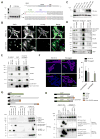The SS18-SSX Oncoprotein Hijacks KDM2B-PRC1.1 to Drive Synovial Sarcoma
- PMID: 29502955
- PMCID: PMC5881394
- DOI: 10.1016/j.ccell.2018.01.018
The SS18-SSX Oncoprotein Hijacks KDM2B-PRC1.1 to Drive Synovial Sarcoma
Erratum in
-
The SS18-SSX Oncoprotein Hijacks KDM2B-PRC1.1 to Drive Synovial Sarcoma.Cancer Cell. 2018 Aug 13;34(2):346-348. doi: 10.1016/j.ccell.2018.07.006. Cancer Cell. 2018. PMID: 30107180 Free PMC article. No abstract available.
Abstract
Synovial sarcoma is an aggressive cancer invariably associated with a chromosomal translocation involving genes encoding the SWI-SNF complex component SS18 and an SSX (SSX1 or SSX2) transcriptional repressor. Using functional genomics, we identify KDM2B, a histone demethylase and component of a non-canonical polycomb repressive complex 1 (PRC1.1), as selectively required for sustaining synovial sarcoma cell transformation. SS18-SSX1 physically interacts with PRC1.1 and co-associates with SWI/SNF and KDM2B complexes on unmethylated CpG islands. Via KDM2B, SS18-SSX1 binds and aberrantly activates expression of developmentally regulated genes otherwise targets of polycomb-mediated repression, which is restored upon KDM2B depletion, leading to irreversible mesenchymal differentiation. Thus, SS18-SSX1 deregulates developmental programs to drive transformation by hijacking a transcriptional repressive complex to aberrantly activate gene expression.
Keywords: CRISPR/Cas9-mediated endogenous protein tagging; DNA methylation; SWI/SNF; epigenetics; non-canonical polycomb repressive complex; oncogenic gene fusion; sarcoma.
Copyright © 2018 Elsevier Inc. All rights reserved.
Conflict of interest statement
The authors declare no competing interests.
Figures








Comment in
-
A Non-canonical Polycomb Dependency in Synovial Sarcoma.Cancer Cell. 2018 Mar 12;33(3):344-346. doi: 10.1016/j.ccell.2018.02.013. Cancer Cell. 2018. PMID: 29533779
References
-
- Baird K, Davis S, Antonescu CR, Harper UL, Walker RL, Chen Y, Glatfelter AA, Duray PH, Meltzer PS. Gene expression profiling of human sarcomas: insights into sarcoma biology. Cancer Res. 2005;65:9226–9235. - PubMed
Publication types
MeSH terms
Substances
Grants and funding
LinkOut - more resources
Full Text Sources
Other Literature Sources
Molecular Biology Databases
Research Materials

